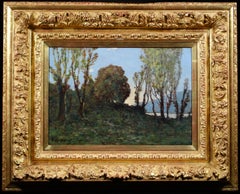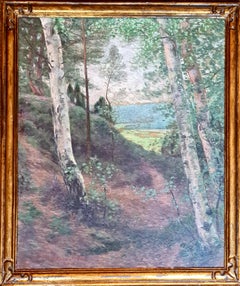Bernardus Johannes Blommers Art
Dutch, 1845-1914
Son of a talented lithographer, he did first the same profession as his father. But at
the Hague Fine Arts Academy, he abandoned the chisel for brushes. He exhibited the
first time in 1869, and had the chance to have his canvas placed beside those of
Josef Isarëls who remarks their quality and takes him as student.
He exhibited everywhere in Amsterdam, The Hague, Paris, Antwerp and received
numerous medals. He remains very indifferent to honors pleased with the only
happiness that gives him his large family, and joy to translate, using his brush, his
admiration for nature.
Blommers paints with delicacy and feeling genre scenes, landscapes but mostly
remains a happy interpreter of the simple life.
Museums:
Amsterdam – Glasgow – Groningen – The Hague – Montreal – Munich – Rotterdam(Biography provided by Galerie L'Angelus)
to
1
1
1
1
Overall Height
to
Overall Width
to
1
1
1
1
6,827
3,109
2,517
1,217
1
1
1
1
Artist: Bernardus Johannes Blommers
L'attente
By Bernardus Johannes Blommers
Located in Barbizon, FR
BLOOMERS
"L’attente”
Oil on panel. 30 x 26.5 cm. Signed lower right
Son of a talented lithographer, he was initially destined for the same profession as his father. But at the Acade...
Category
19th Century Barbizon School Bernardus Johannes Blommers Art
Materials
Oil, Wood Panel
Related Items
Bords de riviere a Saint-Prive - Barbizon Landsape Oil - Henri Joseph Harpignies
By Henri Joseph Harpignies
Located in Marlow, Buckinghamshire
Signed and dated Barbizon School landscape oil on panel by French painter Henri Joseph Harpignies. The work depicts the trees lining the banks of the River Loing at Saint Prive in no...
Category
1910s Barbizon School Bernardus Johannes Blommers Art
Materials
Oil, Panel
The Forest, Large Barbizon School, Oil on Canvas Wooded Landscape
By Emile Roux-Fabre
Located in Cotignac, FR
A French Barbizon School oil on canvas forest view by Emile Roux-Fabre. The painting is signed and dated bottom left with a dedication.
A charming view of forest glade leading out to a valley landscape beyond. The artist has captured the magic feeling of the cool forest shade against the sunshine of the landscape beyond. The texture of the bark on the silver birch trees, the contrast of the leaves on the trees all framing the perspective to the view beyond. An extremely accomplished and atmospheric painting.
The Barbizon school of painters was part of an art movement towards Realism in art, which arose in the context of the dominant Romantic Movement of the time. The Barbizon school was active roughly from 1830 through 1870. It takes its name from the village of Barbizon, France, on the edge of the Forest of Fontainebleau, where many of the artists gathered. Most of their works were landscape paintings, but several of them also painted landscapes with farmworkers, and genre scenes of village life. Some of the most prominent features of this school are its tonal qualities, colour, loose brushwork, and softness of form.
The leaders of the Barbizon school were: Théodore Rousseau, Charles-François Daubigny, Jules Dupré, Constant Troyon, Charles Jacque, and Narcisse Virgilio Díaz. Jean-François Millet lived in Barbizon from 1849, but his interest in figures with a landscape backdrop sets him rather apart from the others. Jean-Baptiste-Camille Corot was the earliest on the scene, first painting in the forest in 1829, but his work has a poetic and literary quality which sets him somewhat apart. Other artists associated with the school, often pupils of the main group, include: Henri Harpignies, Albert Charpin, François-Louis Français and Émile van Marcke.
In 1824 the Salon de Paris exhibited works of John Constable, an English painter. His rural scenes influenced some of the younger artists of the time, moving them to abandon formalism and to draw inspiration directly from nature. Natural scenes became the subjects of their paintings rather than mere backdrops to dramatic events. During the Revolutions of 1848 artists gathered at Barbizon to follow Constable's ideas, making nature the subject of their paintings. The French landscape became a major theme of the Barbizon painters.
Millet extended the idea from landscape to figures — peasant figures, scenes of peasant life, and work in the fields. In The Gleaners (1857), for example, Millet portrays three peasant women working at the harvest. Gleaners are poor people who are permitted to gather the remains after the owners of the field complete the main harvest. The owners (portrayed as wealthy) and their laborers are seen in the back of the painting. Millet shifted the focus and the subject matter from the rich and prominent to those at the bottom of the social ladders. To emphasize their anonymity and marginalized position, he hid their faces. The women's bowed bodies represent their everyday hard work.
In the spring of 1829, Jean-Baptiste-Camille Corot came to Barbizon to paint in the Forest of Fontainebleau, he had first painted in the forest at Chailly in 1822. He returned to Barbizon in the autumn of 1830 and in the summer of 1831, where he made drawings and oil studies, from which he made a painting intended for the Salon of 1830; "View of the Forest of Fontainebleau'" (now in the National Gallery in Washington) and, for the salon of 1831, another "View of the Forest of Fontainebleau"'. While there he met the members of the Barbizon school: Théodore Rousseau, Paul Huet, Constant Troyon, Jean-François Millet, and the young Charles-François Daubigny.
During the late 1860s, the Barbizon painters attracted the attention of a younger generation of French artists studying in Paris. Several of those artists visited Fontainebleau Forest to paint the landscape, including Claude Monet, Pierre-Auguste Renoir, Alfred Sisley and Frédéric Bazille. In the 1870s those artists, among others, developed the art movement called Impressionism and practiced 'plein air' painting. In contrast, the main members of the school made drawings and sketches on the spot, but painted back in their studios.
The Post-Impressionist painter Vincent Van Gogh studied and copied several of the Barbizon painters as well, including 21 copies of paintings by Millet. He copied Millet more than any other artist. He also did three paintings in Daubigny's Garden.
The Barbizon painters also had a profound impact on landscape painting in the United States. This included the development of the American Barbizon school by William Morris Hunt. Several artists who were also in, or contemporary to, the Hudson River School studied Barbizon paintings for their loose brushwork and emotional impact. A notable example is George Inness, who sought to emulate the works of Rousseau. Paintings from the Barbizon school also influenced landscape painting in California. The artist Percy Gray...
Category
Early 20th Century Barbizon School Bernardus Johannes Blommers Art
Materials
Canvas, Oil
H 24.02 in W 20.08 in D 0.79 in
Fishing by Moonlight manner of Corot: Mooonlit lake French Barbizon oil painting
By Jean-Baptiste-Camille Corot
Located in Norwich, GB
Nobody quite does moonlight quite like Camille Corot. Moonlit landscapes suited the artist's discreet artist's personality and painting. As Baudelaire astutely observed: "M. Corot is...
Category
1860s Barbizon School Bernardus Johannes Blommers Art
Materials
Wood Panel, Oil
H 10.04 in W 13.59 in D 0.79 in
Large 19th century French Barbizon school oil - The outdoor concert - Monticelli
Located in Antwerp, BE
Large 19th century Barbizon painting "The outdoor concert"
This peaceful and dreamy painting depicts a group of elegantly dressed people in a magnificent park. The painting has wond...
Category
19th Century Barbizon School Bernardus Johannes Blommers Art
Materials
Oil, Panel
"a Fontainebleu, " Charles Francis DeKlyn, Barbizon oil, French countryside
Located in Wiscasset, ME
Charles Francis De Klyn was born in Westchester County, New York, in 1865. A landscape, marine, portrait and figure painter, De Klyn studied in New York and Paris from 1886 to 1891, then taught at the Cleveland Art Club and the Cleveland School of Art. In 1893, he was one of the founders of the Cleveland Brush and Palette Club, and he exhibited at the National Academy of Design in 1894 and 1895. He was also a member of the Society of Western Artists.
"A Fontainebleu" by Charles Francis De Klyn is a beautifully rendered Barbizon oil...
Category
Late 19th Century Barbizon School Bernardus Johannes Blommers Art
Materials
Oil, Panel
Light on the water, luminous river landscape with two lone figures painting
By Charles Lapostolet
Located in Norwich, GB
There is a lot to see in this delicate, luminous landscape: a little fisherman, a figure in his canoe, and the beautiful light on the water. It is an ...
Category
Mid-19th Century Barbizon School Bernardus Johannes Blommers Art
Materials
Oil, Wood Panel
H 15.36 in W 22.05 in D 2.37 in
A Christmas Winter Wonderland, Barbizon School Snowscape.
Located in Cotignac, FR
An oil on panel view of a winter snow scene by Boggio. The painting is signed bottom right.
A charming view of a snow scene, a river running under a bridge heavy with snow. A Christ...
Category
Mid-20th Century Barbizon School Bernardus Johannes Blommers Art
Materials
Board, Oil
A Winter Wonderland, Barbizon School Snowscape.
Located in Cotignac, FR
An oil on panel view of a winter snow scene by Boggio. The painting is signed bottom right.
A charming view of a snow scene, a river running by a bank heavy with snow.
Category
Mid-20th Century Barbizon School Bernardus Johannes Blommers Art
Materials
Oil, Board
Oaks at Belle-Croix - Fontainebleau, France
By Auguste Anastasi
Located in PARIS, FR
Auguste Paul Charles ANASTASI
(Paris, 1820-Paris, 1889)
Land and oaks at Belle-Croix - Fontainebleau
Oil on canvas
Stamp of the ANASTASI sale on the stretcher
33 x 41cm
Provenance...
Category
Late 19th Century Barbizon School Bernardus Johannes Blommers Art
Materials
Oil
Fine 19th Century French Barbizon Oil on Cradled Wood Woodland Glade Forest
Located in Cirencester, Gloucestershire
The Barbizon Forest
circle of Jean-Baptiste Camille Corot (French 19th century
bears signature,
oil on wood panel (cradled), unframed
panel: 30 x 19 inches
provenance: private collec...
Category
Late 19th Century Barbizon School Bernardus Johannes Blommers Art
Materials
Oil
19th century French Barbizon School Painting oil on Canvas Landscape circa 1840
Located in Portland, OR
19th century French Barbizon School Painting, oil on canvas signed "Marin", Circa 1840. A very attractive bucolic, pastoral landsacpe scene with sheep grazing on the banks of a lake ...
Category
Early 19th Century Barbizon School Bernardus Johannes Blommers Art
Materials
Canvas, Oil
H 19.5 in W 24 in D 3 in
Antique French Barbizon Signed Oil Painting Figure in Boat River Landscape
Located in Cirencester, Gloucestershire
Barbizon School, late 19th/ early 20th century
indistinctly signed lower corner
inscribed verso
oil painting on board, framed
framed: 22 x 16.5 inches
board: 16.5 x 11 inches
provena...
Category
19th Century Barbizon School Bernardus Johannes Blommers Art
Materials
Oil
Previously Available Items
Retour de pêche
By Bernardus Johannes Blommers
Located in Barbizon, FR
oil painting on cardboard mounted on pannel signed lower right.
Category
Late 19th Century Realist Bernardus Johannes Blommers Art
Materials
Oil
Bernardus Johannes Blommers art for sale on 1stDibs.
Find a wide variety of authentic Bernardus Johannes Blommers art available for sale on 1stDibs. You can also browse by medium to find art by Bernardus Johannes Blommers in oil paint, paint, panel and more. Not every interior allows for large Bernardus Johannes Blommers art, so small editions measuring 11 inches across are available. Customers who are interested in this artist might also find the work of Alfred East, Leon Richet, and Henri Joseph Harpignies. Bernardus Johannes Blommers art prices can differ depending upon medium, time period and other attributes. On 1stDibs, the price for these items starts at $8,783 and tops out at $8,783, while the average work can sell for $8,783.



